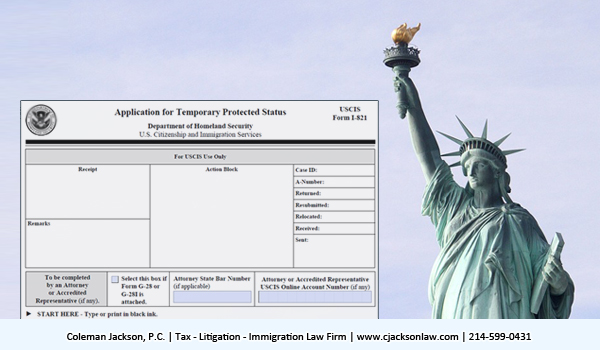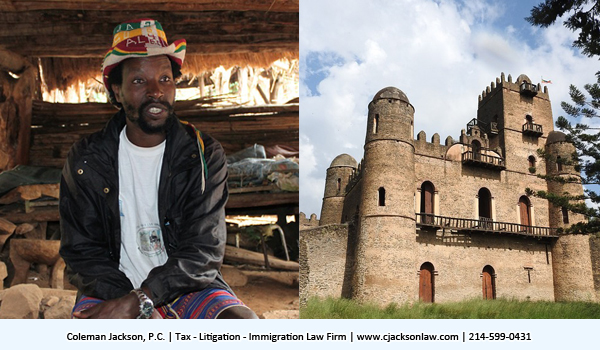By: Coleman Jackson, Attorney
December 24, 2022
FIRST LET US TALK ABOUT TEMPORARY PROTECTED STATUS IN GENERAL TERMS:
Temporary Protected Status (TPS) was established by U.S. Congress in 1990. Congress established TPS as part of the Immigration Act of 1990 to provide humanitarian relief to citizens of foreign countries whose countries were suffering from natural disasters, protracted unrest, or conflict. What is important to know about TPS
What is TPS?
TPS is a program that allows migrants whose home countries are considered unsafe the right to live and work in the United States for a temporary, but extendable, period of time. Though they are not considered lawful permanent residents or U.S. citizens, many have lived in the United States for more than twenty years. TPS is for people who cannot go back to their home country because of danger. These may include armed conflict, environmental disasters, or other temporary dangers. This status is only available to nationals and individuals having no nationality who last habitually resided in the designated country. The Department of Homeland Security (DHS) Secretary is the designating authority of the U.S. government. The Secretary designated Ethiopia for Temporary Protected Status (TPS for 18 months beginning on December 12, 2022 and ending on June 12, 2024.
What are the benefits of TPS?
- You can stay in the USA legally for a set period of time
- You can apply for a work permit in the USA
- You can apply for a document to travel outside the USA
- You will be protected from detention and deportation
- You can have TPS at the same time as another immigration status. You can apply for asylum, lawful permanent resident status (green card), or other protected status if you meet the requirements for those particular immigration benefits.
How does TPS work?
Once a country receives a TPS designation, any citizen of that country who is already physically present in the United States is eligible to apply for the program provided they meet certain requirements set by U.S. Citizenship and Immigration Services (USCIS), a DHS agency. Disqualifying factors include criminal convictions in the United States and participation in terrorist activities.
The authority to grant a country TPS designation is held by the Secretary of the Department of Homeland Security, who can extend it indefinitely if when concluding that conditions in the country prevent individuals from returning home safely. Reasons for TPS designation include:
- ongoing armed conflict, such as a civil war;
- an environmental disaster, such as an earthquake, hurricane, drought, or epidemic; and other extraordinary and temporary conditions that render the country unsafe.
Once a country’s designation expires, individuals return to the immigration status they held prior to receiving TPS, which for most migrants means reverting to undocumented status and facing the threat of deportation to their country of origin. They can apply for work or student visas, if eligible, though those are temporary. However, those TPS immigrants whose spouses or adult children are citizens or legal permanent residents could be eligible to stay in the country legally upon approval of an immigrant petition. Certain employers also could file immigrant petitions on behalf of TPS workers. Therefore, TPS immigrants may have lots of alternative ways to remain and work in the United States even when their TPS status expires.
NOW LET US TURN OUR FOCUS TO THE U.S. DESIGNATION OF ETHIOPIA FOR TEMPORARY PROTECTED STATUS (TPS):
Who designated TPS for Ethiopia?
On October 21, 2022, the Department of Homeland Security (DHS) designated TPS for Ethiopia due to the current situation. The status will last 18 months from when the federal register notice is shared. DHS recognizes the ongoing armed conflict and the extraordinary and temporary conditions engulfing Ethiopia. This designation is based on both ongoing armed conflict and extraordinary and temporary conditions in Ethiopia that prevent Ethiopian nationals, and those of no nationality who last habitually resided in Ethiopia, from returning to Ethiopia safely. Due to the armed conflict, civilians are at risk of conflict-related violence, including attacks, killings, rape, and other forms of gender-based violence; ethnicity-based detentions; and human rights violations and abuses. Extraordinary and temporary conditions that further prevent nationals from returning in safety include a humanitarian crisis involving severe food insecurity, flooding, drought, large-scale displacement, and the impact of disease outbreaks.
Who Qualifies to apply?
According to USCIS, individuals eligible for TPS under Ethiopia designation must have continuously resided in the United States since October 20, 2022. Individuals who attempt to travel to the United States after October 20, 2022, will not be eligible for TPS under this designation. Ethiopia’s 18-month temporary protection status designation went into effect on December 12, 2022 and ends on June 12, 2024. Anyone who qualifies must apply for TPS within the designation period.
If you are applying for the first time, you must meet the following requirements:
- Be a national of Ethiopia, or a person without nationality who lived in Ethiopia for a long time before arriving in the USA
- Have continuously lived only in the USA since October 20, 2022
- Have not left the USA since October 20, 2022
How to apply?
You can apply for TPS Ethiopia by filing Form I-821, Application for Temporary Protected Status. You can also file your application online with USCIS. You must send documents showing proof of your identity, nationality, date of entry and evidentiary proof that you have continuously resided in the United States of America October 20, 2022. You must pay a fee if you are applying for TPS for the first time. The current filing fee for initial TPS filing is $50 plus $85 biometric fee. You might be able to apply for a fee waiver if you can’t afford to pay the fee.
Further you can apply for employment authorization concurrently when filing Form, I-821 by Filing Form I-765, Application for Employment Authorization. Currently the filing fee for the initial work authorization is $410.
TPS processing time?
There is still no defined processing time for the Ethiopian TPS, but taking into account the others, the process takes around five and a half months to complete.
Law firms, like ours, can help you complete your application, counsel you on assembling evidentiary supporting documents, and review all of your possible immigration options. The United States Embassy in Ethiopia could offer more information. You can contact the U.S. Ethiopian Embassy at (202) 364-1200 or visit its consular offices in Washington D.C., Los Angeles, CA, and St. Paul, Minnesota. USCIS offers other immigration services that may help people affected by extreme situations. Call 800-375-5283 to learn how to request help.
Disclaimer: All of the government contact information is provided as a courtesy to our blog readers. We think it is accurate as of the date of the first publication of this blog. Our law firm is a private law firm without any affiliation with the U.S. government or any other government.
This law blog is written by the Taxation | Litigation | Immigration Law Firm of Coleman Jackson, P.C. for educational purposes; it does not create an attorney-client relationship between this law firm and its reader. You should consult with legal counsel in your geographical area with respect to any legal issues impacting you, your family or business.
Coleman Jackson, P.C. | Taxation, Litigation, Immigration Law Firm | English (214) 599-0431 | Spanish (214) 599-0432 | Portuguese (214) 272-3100








